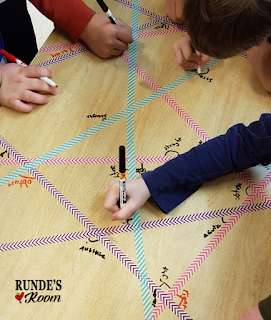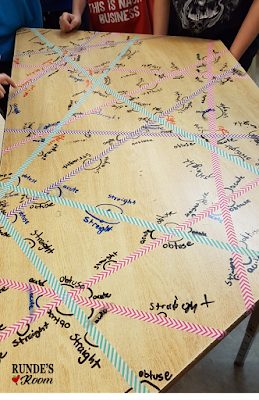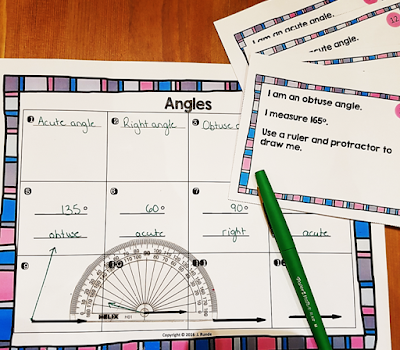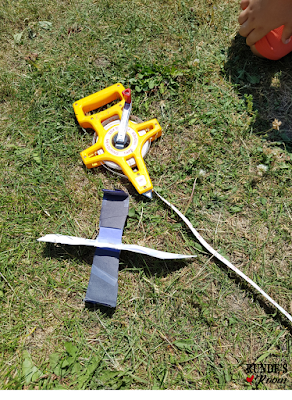5 Activities for Teaching Angles
I love teaching angles - it's short and sweet, and the students always have a lot of success with it - which makes it all the better. :)
1. Interactive Math Journal Entry - this is one of my all-time favorite math journal entries. I use this as a full-class introduction to angles - not as a station. That way, I can gauge what knowledge they come to me with, and we can talk about what we will learn while studying angles. This entry is included in my Interactive Math Journal Resource. If you download the free preview, you can grab this lesson in its entirety. You can also read about this activity in a blog post I have HERE.
For more 5 Activities to Teach .... posts, click HERE.
9
I love teaching angles - it's short and sweet, and the students always have a lot of success with it - which makes it all the better. :)
1. Interactive Math Journal Entry - this is one of my all-time favorite math journal entries. I use this as a full-class introduction to angles - not as a station. That way, I can gauge what knowledge they come to me with, and we can talk about what we will learn while studying angles. This entry is included in my Interactive Math Journal Resource. If you download the free preview, you can grab this lesson in its entirety. You can also read about this activity in a blog post I have HERE.
2. Tables, Whiteboards and Washi Tape -
Get the tape out and get ready for some hands-on fun! (You don't have to use washi tape - masking tape works perfectly fine, too). To introduce angles at the beginning of our unit, we did a full group lesson on classifying angles. I taped up a table, armed students with a whiteboard marker, and let them classify (acute, right, obtuse, and straight) as many angles as they could. They LOVED this activity! So everyone could fit around the table, I paired up the students so they could take turns marking angles on the table.
 Once we were masters at classifying angles, we could move on to measuring angles. This is such a fun activity - perfect for practice at math centers! We just used some fun washi tape to "draw" lines on our whiteboards. We used 5 pieces of tape - and I told them the tape had to be straight and go across the board from one side to the other. From there, students measured the angles made by the tape. You could just leave it at this, but I turned this activity into a game by pairing up the students. Each student had a different color of whiteboard marker. The first student measured an angle (any angle of their choice) and wrote down the measurement using their color. Then, the second student checked the answer. If it was correct, they left it alone. If it was incorrect, they erased the first answer and wrote the correct answer using their color (the second student). The second student then got a chance to pick and measure an angle of their choice - recording the answer in their color. At the end of the activity, the student with the most answers in their color (most correct answers) wins!
Once we were masters at classifying angles, we could move on to measuring angles. This is such a fun activity - perfect for practice at math centers! We just used some fun washi tape to "draw" lines on our whiteboards. We used 5 pieces of tape - and I told them the tape had to be straight and go across the board from one side to the other. From there, students measured the angles made by the tape. You could just leave it at this, but I turned this activity into a game by pairing up the students. Each student had a different color of whiteboard marker. The first student measured an angle (any angle of their choice) and wrote down the measurement using their color. Then, the second student checked the answer. If it was correct, they left it alone. If it was incorrect, they erased the first answer and wrote the correct answer using their color (the second student). The second student then got a chance to pick and measure an angle of their choice - recording the answer in their color. At the end of the activity, the student with the most answers in their color (most correct answers) wins!
Get the tape out and get ready for some hands-on fun! (You don't have to use washi tape - masking tape works perfectly fine, too). To introduce angles at the beginning of our unit, we did a full group lesson on classifying angles. I taped up a table, armed students with a whiteboard marker, and let them classify (acute, right, obtuse, and straight) as many angles as they could. They LOVED this activity! So everyone could fit around the table, I paired up the students so they could take turns marking angles on the table.
 Once we were masters at classifying angles, we could move on to measuring angles. This is such a fun activity - perfect for practice at math centers! We just used some fun washi tape to "draw" lines on our whiteboards. We used 5 pieces of tape - and I told them the tape had to be straight and go across the board from one side to the other. From there, students measured the angles made by the tape. You could just leave it at this, but I turned this activity into a game by pairing up the students. Each student had a different color of whiteboard marker. The first student measured an angle (any angle of their choice) and wrote down the measurement using their color. Then, the second student checked the answer. If it was correct, they left it alone. If it was incorrect, they erased the first answer and wrote the correct answer using their color (the second student). The second student then got a chance to pick and measure an angle of their choice - recording the answer in their color. At the end of the activity, the student with the most answers in their color (most correct answers) wins!
Once we were masters at classifying angles, we could move on to measuring angles. This is such a fun activity - perfect for practice at math centers! We just used some fun washi tape to "draw" lines on our whiteboards. We used 5 pieces of tape - and I told them the tape had to be straight and go across the board from one side to the other. From there, students measured the angles made by the tape. You could just leave it at this, but I turned this activity into a game by pairing up the students. Each student had a different color of whiteboard marker. The first student measured an angle (any angle of their choice) and wrote down the measurement using their color. Then, the second student checked the answer. If it was correct, they left it alone. If it was incorrect, they erased the first answer and wrote the correct answer using their color (the second student). The second student then got a chance to pick and measure an angle of their choice - recording the answer in their color. At the end of the activity, the student with the most answers in their color (most correct answers) wins!
3. TIME for Angles - This is a quick activity I do at various points throughout the day while we are studying angles. (I also throw in a few days here and there just to review the concept). At any given time, I ask the students what time it is on our analog clock (that is good practice just in itself). I record the time and ask the students what kind of angle it is - acute, right, obtuse, straight. I also ask them to estimate the size of the angle. When doing this, the students realized that each 5 minute interval was 30 degrees - so helpful for estimating.I just keep a running record on the board by the clock and try to get in at least 5 questions throughout the day.
4. What's in a Name? - This one is another great station activity - and will also make a great math bulletin board display when students are complete. I like to use grid (graph) paper for this activity, but it's not necessary. Have the students write their names in block letters (all straight lines) on the paper. Then, using a protractor, have the students measure all the angles they can find in their names. This is also a great way to start to introduce adjacent angles (and complementary and supplementary angles).
5. Angle Task Cards - This is another great station activity. These Angle Task Cards contain a Minds-On Task which I like to use to introduce the concept to the whole class, with each student completing the challenge task on a whiteboard or paper. The twelve task cards can then be completed independently as part of a station, with each student completing the recording sheet to hand in for a formative assessment. The best part about the recording sheet is that it is perfectly matched up to the answer sheet, so you only need to place the recording sheet over the answer sheet in a light area (like a window) so you can see the answers through the page and easily mark without having to measure each angle. These task cards also make great exit slips after a lesson. You can take a peek at them on TpT by clicking HERE.
I also have a more advanced set of task cards for angle relationships - finding the unknown angles with the properties of complementary and supplementary angles, opposite angles, and interior and exterior angles. You can take a peek at them by clicking on the picture to the right or HERE.
5. Angle Task Cards - This is another great station activity. These Angle Task Cards contain a Minds-On Task which I like to use to introduce the concept to the whole class, with each student completing the challenge task on a whiteboard or paper. The twelve task cards can then be completed independently as part of a station, with each student completing the recording sheet to hand in for a formative assessment. The best part about the recording sheet is that it is perfectly matched up to the answer sheet, so you only need to place the recording sheet over the answer sheet in a light area (like a window) so you can see the answers through the page and easily mark without having to measure each angle. These task cards also make great exit slips after a lesson. You can take a peek at them on TpT by clicking HERE.
I also have a more advanced set of task cards for angle relationships - finding the unknown angles with the properties of complementary and supplementary angles, opposite angles, and interior and exterior angles. You can take a peek at them by clicking on the picture to the right or HERE.
What are some of your best teaching ideas or activities for angles? I'd love for you to leave a comment below to share with us.
For more 5 Activities to Teach .... posts, click HERE.
















































